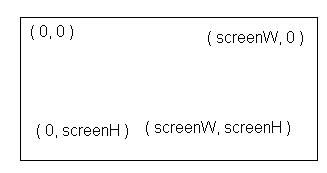Some very good points. Still, nothing is being rendered though. Grr.
The main loop has been changed to -
while ( true ) { glClear( GL_COLOR_BUFFER_BIT | GL_DEPTH_BUFFER_BIT ); gluOrtho2D( 0, 640, 480, 0 ); glColor3f( 1, 1, 1 ); glBegin( GL_TRIANGLE_STRIP ); glVertex2i( 0, 0 ); glVertex2i( 0, 100 ); glVertex2i( 100, 0 ); glVertex2i( 100, 100 ); glEnd(); SDL_GL_SwapBuffers();}
I swapped the arguments in gluOrtho2D as suggested, though I'd assume that would just flip the coordinates around - so that wouldn't be too much of a problem. I also made the triangle bigger, and a square. I've also removed the OO calls, which were for the most part a wrapper around the OGL calls. And still nothing works.
The only code left is the init code, but as something
is rendered when the projection matrix is set to the identity, I'm assuming at this point that the init code kind of works. Its pretty short (yay SDL) so I might as well post it here too -
bool OGLGfxAdapter::_createScreenSurface( int screenW, int screenH, bool fullscreen ) { if ( SDL_Init( SDL_INIT_VIDEO ) != 0 ) { return false; } SDL_GL_SetAttribute( SDL_GL_RED_SIZE, 5 ); SDL_GL_SetAttribute( SDL_GL_BLUE_SIZE, 5 ); SDL_GL_SetAttribute( SDL_GL_GREEN_SIZE, 5 ); SDL_GL_SetAttribute( SDL_GL_DEPTH_SIZE, 16 ); SDL_GL_SetAttribute( SDL_GL_DOUBLEBUFFER, 1 ); unsigned int flags = SDL_DOUBLEBUF | SDL_OPENGL | SDL_HWSURFACE; if ( fullscreen ) flags |= SDL_FULLSCREEN; _screen = SDL_SetVideoMode( screenW, screenH, 16, flags ); if ( !_screen ) return false; glMatrixMode( GL_PROJECTION ); glLoadIdentity(); glMatrixMode( GL_MODELVIEW ); glLoadIdentity(); return true;}
This code is called from the constructor of OGLGfxAdapter with the parameters (640, 480, false).
And I'm going to hit the sack - I remember having a problem with glOrtho a while back, but I distinctly remember solving it. Arrgh! It seems I grow stupider with each passing day.
Anyone know what I'm doing wrong?
 Where the points shown correlate to the vertex positions.
So yeah... help? :(
[Edited by - Mushu on April 13, 2006 1:42:16 AM]
Where the points shown correlate to the vertex positions.
So yeah... help? :(
[Edited by - Mushu on April 13, 2006 1:42:16 AM]




